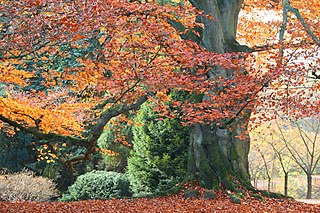
Beech (Fagus) is a genus of deciduous trees in the family Fagaceae, native to temperate Europe, Asia, and North America.

Tree spiking involves hammering a metal rod, nail, or other material into a tree trunk, either inserting it at the base of the trunk where a logger might be expected to cut into the tree, or higher up where it would affect the sawmill later processing the wood. It is used to prevent logging by risking damage to saws, in the forest or at the mill, if the tree is cut. The spike reduces the commercial value of the wood by causing discoloration, thereby reducing the economic viability of logging in the long term, without threatening the life of the tree.

Nothofagus, also known as the southern beeches, is a genus of 43 species of trees and shrubs native to the Southern Hemisphere in southern South America and Australasia. The species are ecological dominants in many temperate forests in these regions. Some species are reportedly naturalised in Germany and Great Britain. The genus has a rich fossil record of leaves, cupules and pollen, with fossils extending into the late Cretaceous and occurring in Australia, New Zealand, Antarctica and South America. In the past, they were included in the family Fagaceae, but genetic tests revealed them to be genetically distinct, and they are now included in their own family, the Nothofagaceae.

The Haast Pass, a mountain pass in the Southern Alps of the South Island of New Zealand, takes its name from Julius von Haast, a 19th-century explorer who also served as Provincial Geologist for the Provincial government of Canterbury. Māori used the pass in pre-European times, but not on a regular basis.
Forest & Bird, also known by its formal name as the Royal Forest and Bird Protection Society of New Zealand Inc., is an environmental organisation specialising in the protection and conservation of New Zealand's indigenous flora and fauna and unique wild places and natural ecosystems. Forest & Bird consists of 47 branches located in urban and rural centres throughout New Zealand. Branches are actively engaged in conservation projects and advocacy on a community, regional and national basis. Forest & Bird has offices and staff located in Auckland, Christchurch, Wellington, Nelson and Dunedin. Forest & Bird publishes a quarterly magazine Forest & Bird, one of New Zealand's definitive natural history and conservation publications.
This is a timeline of environmental history of New Zealand. It includes notable events affecting the natural environment of New Zealand as a result of human activity.
The Ecologic Foundation is an environmental organisation in New Zealand.

Conservation in New Zealand has a history associated with both Māori and Europeans. Both groups of people caused a loss of species and both altered their behaviour to a degree after realising their effect on indigenous flora and fauna.

The environmental movement in New Zealand started in the 1960s, a period of rapid social change. Since then numerous high-profile national campaigns have contested various environmental issues. The environmental movement eventually spawned the Values Party, which was the first political party with a strong focus on environmental issues to contest national elections. The Values Party eventually morphed into the Green Party of Aotearoa New Zealand.

Secrets and Lies, subtitled "the anatomy of an anti-environmental PR campaign", is a 1999 book by Nicky Hager and Bob Burton.
The New Zealand Forest Accord is an accord among forestry associations and environmental groups that was signed in 1991.
The Maruia Declaration was a public petition calling for the immediate phasing out of the logging of virgin native forest in New Zealand.
The West Coast Accord was an agreement signed on 6 November 1986 between government, industry and environmental organisations concerning the forests of the West Coast of New Zealand.

The environment of New Zealand is characterised by an endemic flora and fauna which has evolved in near isolation from the rest of the world. The main islands of New Zealand span two biomes, temperate and subtropical, complicated by large mountainous areas above the tree line. There are also numerous smaller islands which extent into the sub antarctic. The prevailing weather systems bring significantly more rain to the west of the country. New Zealand's territorial waters extend cover a much larger area than its landmass and extend over the continental shelf and abyssal plateau in the South Pacific Ocean, Tasman Sea and Southern ocean.
Deforestation in New Zealand has been a contentious environmental issue in the past, but now native forests, colloquially called "the bush", now have legal protection, and are not allowed to be tampered with by humans.

Forestry in New Zealand has a history starting with European settlement in the 19th century and is now an industry worth seven percent of annual revenue. Much of the original native forest cover was burnt off and logged, however forests have been extensively planted, predominantly with fast-growing cultivars of the Monterey Pine. Wood chips, whole logs, lumber and paper products are exported from New Zealand.

The Nelson Coast temperate forests are an ecoregion in New Zealand.

Victoria Forest Park, is situated on the West Coast of the South Island of New Zealand. At 2,069 square kilometres (799 sq mi) it is New Zealand's largest forest park. The park is administered by the Department of Conservation (DOC).











